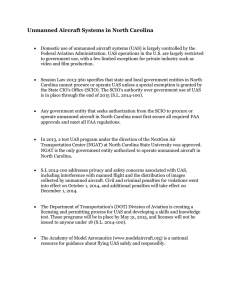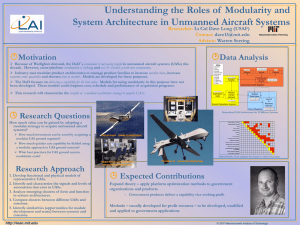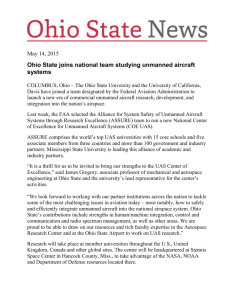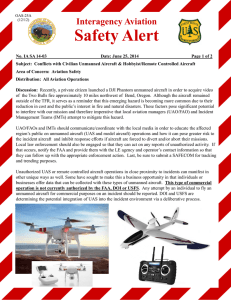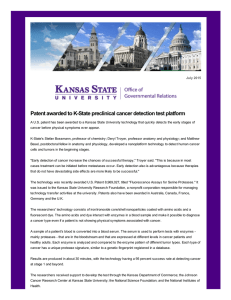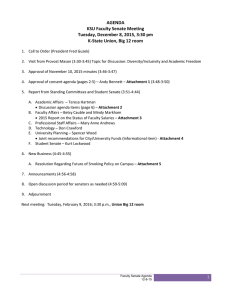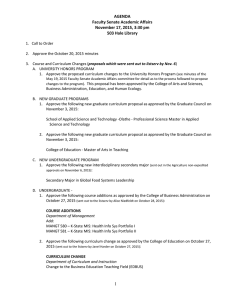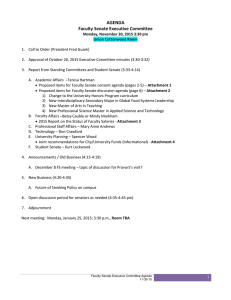Attachment 2 College of Technology & Aviation, K‐State Salina (1‐8‐15) Academic Affairs
advertisement
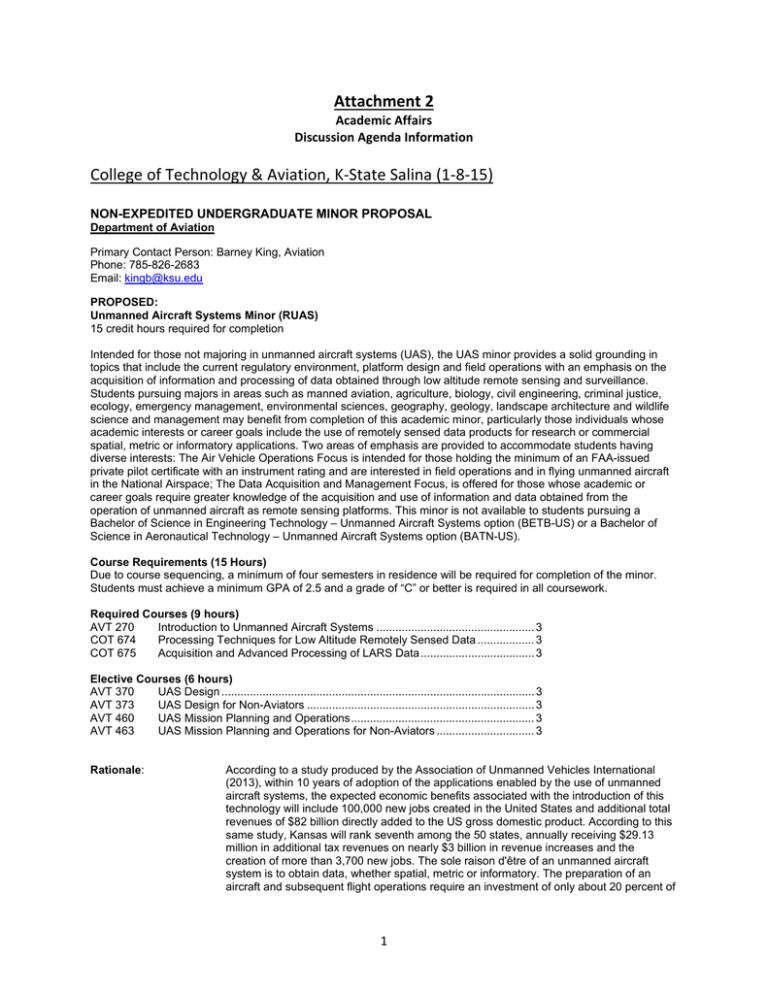
Attachment 2 Academic Affairs Discussion Agenda Information College of Technology & Aviation, K‐State Salina (1‐8‐15) NON-EXPEDITED UNDERGRADUATE MINOR PROPOSAL Department of Aviation Primary Contact Person: Barney King, Aviation Phone: 785-826-2683 Email: kingb@ksu.edu PROPOSED: Unmanned Aircraft Systems Minor (RUAS) 15 credit hours required for completion Intended for those not majoring in unmanned aircraft systems (UAS), the UAS minor provides a solid grounding in topics that include the current regulatory environment, platform design and field operations with an emphasis on the acquisition of information and processing of data obtained through low altitude remote sensing and surveillance. Students pursuing majors in areas such as manned aviation, agriculture, biology, civil engineering, criminal justice, ecology, emergency management, environmental sciences, geography, geology, landscape architecture and wildlife science and management may benefit from completion of this academic minor, particularly those individuals whose academic interests or career goals include the use of remotely sensed data products for research or commercial spatial, metric or informatory applications. Two areas of emphasis are provided to accommodate students having diverse interests: The Air Vehicle Operations Focus is intended for those holding the minimum of an FAA-issued private pilot certificate with an instrument rating and are interested in field operations and in flying unmanned aircraft in the National Airspace; The Data Acquisition and Management Focus, is offered for those whose academic or career goals require greater knowledge of the acquisition and use of information and data obtained from the operation of unmanned aircraft as remote sensing platforms. This minor is not available to students pursuing a Bachelor of Science in Engineering Technology – Unmanned Aircraft Systems option (BETB-US) or a Bachelor of Science in Aeronautical Technology – Unmanned Aircraft Systems option (BATN-US). Course Requirements (15 Hours) Due to course sequencing, a minimum of four semesters in residence will be required for completion of the minor. Students must achieve a minimum GPA of 2.5 and a grade of “C” or better is required in all coursework. Required Courses (9 hours) AVT 270 Introduction to Unmanned Aircraft Systems .................................................. 3 COT 674 Processing Techniques for Low Altitude Remotely Sensed Data .................. 3 COT 675 Acquisition and Advanced Processing of LARS Data .................................... 3 Elective Courses (6 hours) AVT 370 UAS Design ................................................................................................... 3 AVT 373 UAS Design for Non-Aviators ........................................................................ 3 AVT 460 UAS Mission Planning and Operations .......................................................... 3 AVT 463 UAS Mission Planning and Operations for Non-Aviators ............................... 3 Rationale: According to a study produced by the Association of Unmanned Vehicles International (2013), within 10 years of adoption of the applications enabled by the use of unmanned aircraft systems, the expected economic benefits associated with the introduction of this technology will include 100,000 new jobs created in the United States and additional total revenues of $82 billion directly added to the US gross domestic product. According to this same study, Kansas will rank seventh among the 50 states, annually receiving $29.13 million in additional tax revenues on nearly $3 billion in revenue increases and the creation of more than 3,700 new jobs. The sole raison d'être of an unmanned aircraft system is to obtain data, whether spatial, metric or informatory. The preparation of an aircraft and subsequent flight operations require an investment of only about 20 percent of 1 the total time involved in the enterprise, whereas the acquisition and processing of the data consumes the remainder. Thus, 80 percent of the efforts invested to create these economic benefits will be attributable to the acquisition and processing of data to support areas such as precision agriculture, infrastructure monitoring and evaluation, surveying and mapping, wildlife and wildfire management, pipeline and power line patrols, weather and environmental monitoring, mineral and energy exploration, among a multitude of other applications. The rationale for proposing this minor is to provide students with the research tools with which to obtain empirically derived information and the skills and knowledge to obtain employment as productive employees in the anticipated expansion of the global economy. The addition of this “stand-alone” minor to the K-State curricula will benefit a diverse group of students, including those from other universities. The minor is available to students currently enrolled at accredited universities or graduates who have a cumulative GPA of 2.0 (on a scale of zero to four) or higher. Non-Kansas State University students must apply to the university and be accepted as an undergraduate student. It is hoped that, subsequent to approval of the UAS Minor, a mutually beneficial articulation can be reached with Kansas Wesleyan University, whereby students from the KWU Emergency Management program will enroll in the KSU UAS Minor and those from KState can enroll in the KWU Emergency Management Minor. Discussions in this area are ongoing. This minor is intended to replace the existing three-course UAS certificate. IMPACT: No impact on any other department EFFECTIVE DATE: Fall 2015 2
